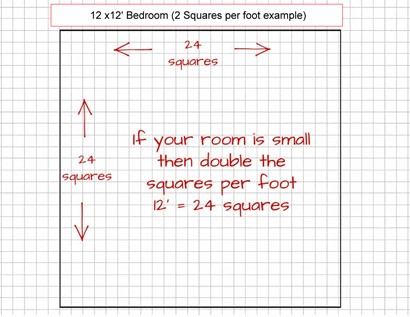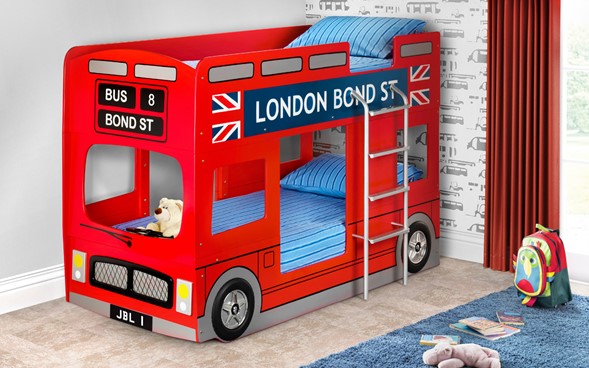When you’re working with a small bedroom, there are several tricks to free up floor space and make better use of the space available.

Twin beds are popular in spare bedrooms and shared bedrooms, and they can work very well so long as some floor space is preserved.
Clearly, you can’t squeeze something in that won’t fit, but you can choose efficiently sized furniture and choose your layout wisely.
Here’s how to fit two twin beds in a small room:
Minimum size
First of all, to fit two twin beds in a room, the room needs to be at least 7 feet by 10 feet to ensure you have room to walk around. Some experts recommend 10 x 10, but 7 x 10 should be adequate for most spaces.
Measure the room and make sure it meets this minimum requirement. If it doesn’t, don’t bother trying – two twin beds won’t fit! A single bed is 190cm (6 ft 3″) long, so you need that 7 feet to be able to walk around.
Fitting the beds in
There are two ways to fit the beds in:• Remove all furniture from the bedroom, build the beds, and then reintroduce furniture to test the layout in real life• Sketch the bedroom outline, add dimensions, and strategically plan the layout as well as the mattress sizes based on the measurements you add
In our opinion, option #2 is the better way.
Measure and sketch the room• Take a sheet of paper and draw the shape of your bedroom• Measure the door and all walls. Add these dimensions to your room drawing• Sketch in the twin beds. You can add realistic, dimensional drawings by measuring the length of the room. A single bed is 6 ft 3″ long. Take the time to check over mattress dimensions to make sure your drawings are correct. How much space is left over? You can add the space left over to your drawing in inches or cm.• Sketch in additional furniture. If you already own furniture, you will have a sense of whether the furniture will fit already.

Selecting the twin beds
Twin beds can be configured in multiple different ways. The idea is to preserve usable floor space so that you have room to walk around.
To be honest, the layout of the room is determined by its size. When you’re working with small rooms, you don’t have that many options.
So, selecting twin beds comes down to space. Here are your options:• Corner twin beds with a storage unit• Standard twin beds aligned in parallel• Bunk beds if there’s no floor space for two twin beds (ideal for young children)

Kid’s beds
If the bedroom is for children, you can use children’s beds. Kids beds are shorter and narrower than standard single beds, so they free up floor space.
Options include low or high footboards, sprung or solid slats, and metal or wooden frames. Most kids prefer a wooden bed because it isn’t as cold. Some kid’s beds also have built-in drawers, helping keep the bedroom clutter-free.
Day bed & under-bed combo
If you only need one permanent bed and a temporary bed for a kid’s bedroom, a day bed and under bed combo is a great option. For example, the Madrid day bed is ideal for children, and it has a slide-out under-bed for sleepovers.

Day and under-bed combos are also perfect for sleepover rooms and playrooms, doubling up as a sofa when not used as a bed.
Making efficient use of space
Whether you need to fit two single beds or two kid’s beds into a small room, maximising space is crucial to make it a nice place to spend time.
We recommend tiered shelves to move clutter off the floor, wall baskets and wall nets for teddies and soft toys, colour-coded plastic stackable storage boxes and a small toy storage unit with slide-out plastic buckets.
With chests, wardrobes and other heavy furniture, remember to fix these to the wall to prevent tipping, especially in children’s rooms.
Categories
- #bookclub52
- #FromTheKitchenOf
- #littleloves
- #MySundayPhoto
- #OrdinaryMoments
- #reciperoundup
- 2018 Bucket List
- 52 recipes 52 weeks
- Attitude!
- B&M Ambassador
- Beauty
- Birth Story
- Blog
- blog link
- blog link up
- Blogger Series…
- Blogmas 2018
- Book Club 2023
- Book club 52
- Books
- Budget
- Bujo
- Christmas 2017
- Christmas 2018
- Christmas 2019
- Christmas 2020
- Christmas 2021
- Christmas Food 2019
- Christmas Gift Guide 2019
- collaborative post
- competition
- crafts
- dating
- Days out
- Drinks
- Durham Events
- Family
- Family Days Out
- Fathers Day
- Food
- Gift Guide
- Giveaway
- Guest
- Guest post
- Halloween
- Health & Fitness
- Home
- Home Education
- Horror
- In The Craftroom With
- In the Kitchen with…
- Large Family
- Large family meal planning
- lists
- Little ones!
- Living Arrows
- Living Arrows 2018
- Love
- Me & Mine
- Meal Planning
- Mississippi
- Money
- Monthly Bucket List
- Mothers Day
- movies
- North East Days Out
- Pets
- PR
- Projects
- Rainy Day Crafts
- recipe
- Recipe Round Up
- Reviews
- rge Family Meal Planning
- Seasonal
- self care
- Sibling Linky
- Slimming World
- Slimming World Recipes
- Spell Jar Season
- Staycation Series – Durham
- Style
- top 5
- Travel
- Tutorials
- Uncategorized
- Valentines Day 2019
- valentines day 2020
- Whattheredheadsaid
- witch/wicca
Recent Posts
- Home and Garden Ideas to Boost Property Value
- The Art of Blending Modern and Traditional Design in Your Home
- The Best Night’s Sleep: My Honest Origin Bed & Mattress Review / AD
- Ancestor Connection Jar: Honoring the Wisdom That Flows Through You
- DIY Thanksgiving Table Runner: Paper Pieced Fall Craft for Elegant Holiday Tables
- Halloween Movies To Watch As A FamilyThe Ultimate Family Halloween Movie Night Guide: Spooky Fun for Every Age
- DIY Thanksgiving Place Cards: Elegant Paper Craft for Holiday Table Settings
- Third Eye Opening Jar: Trusting Your Maternal Intuition
- DIY Autumn Window Clings: Easy Paper Craft for Cozy Fall Home Decor
- DIY Fall Gratitude Tree: Interactive Paper Craft for Family Thanksgiving Traditions
Archives
Recent Comments
- DIY Halloween Countdown Calendar: Interactive Paper Craft for Family Fun on 3D Paper Bat Wall Swarm: Easy Halloween Decor That Makes a Statement
- Vintage Halloween Paper Garland: Easy Paper Craft Tutorial for Spooky Home Decor on 3D Paper Bat Wall Swarm: Easy Halloween Decor That Makes a Statement
- 3D Paper Bat Wall Swarm: Easy Halloween Decor That Makes a Statement on DIY Halloween Gothic Paper Lanterns: Easy Paper Craft Tutorial for Spooky Home Decor
- DIY Halloween Gothic Paper Lanterns: Easy Paper Craft Tutorial for Spooky Home Decor on 3D Paper Bat Wall Swarm: Easy Halloween Decor That Makes a Statement
- Essential Tools to Protect your Smart Home on Consider These Home Improvements to Elevate Your Living Experience
